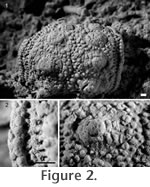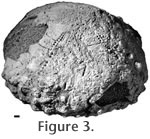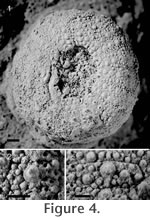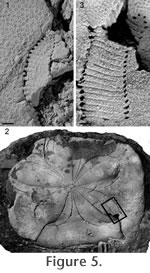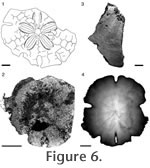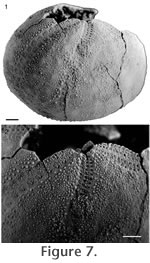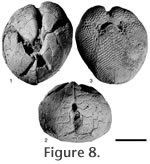|
|
|
Systematic PalaeontologyEchinoidea
Leske, 1778 Type species. - Prionocidaris pistillaris (Lamarck, 1816), by original designation. Range and distribution. - Lower Cretaceous (Albian) to Recent, worldwide. Prionocidaris sp.
Remarks. - Fossils of the genus Prionocidaris are known from the Late Cretaceous to Miocene. Therefore, our Late Miocene to Pliocene specimen appears to be the youngest known fossil of this genus. Furthermore, the genus Prionocidaris shows a different geographical distribution of fossil and extent species (Mortensen 1928). Prionocidaris fossils are known from Europe and the Mediterranean as well as from the entire Caribbean. Extant species, however, are known from the Indian and the Pacific Ocean. Stratigraphic range. - The La Vela Formation (Late Miocene to Pliocene). Locality. - La Vela region, Falcón State, Venezuela. Material. - Fragment showing one interambulacrum and adjacent ambulacra broken along the perradial suture on both sides, UNEFM-IF-001. Arbacioida
Gregory, 1900 Type species. - Arbacia lixula (Linnaeus, 1758), by subsequent designation of Agassiz and Clark, (1908: 67). Range and distribution. - Miocene to Recent, Mediterranean, both coasts of Central and South America. Arbacia punctulata (Lamarck, 1816)
Remarks. - Arbacia punctulata is a well known species of Pliocene age. It is distributed throughout the western Atlantic seaboard and the whole Caribbean. It is very similar to the two Pacific coast species A. spatuligera (Valenciennes, 1846) and A. stellata (Blainville, 1825). Aside from coloration and spine morphology, which are not preserved, A. punctulata appears not to have any morphological differences to A. stellata. The difference to A. spatuligera is more obvious since A. punctulata has tubercles of equal size both on the interambulacra and the adradial series in contrast to its Pacific coast relative with smaller tubercles on the inner interambulacra (Mortensen 1935). Stratigraphic range. - Cocuiza Member of the San Gregorio Formation (Late Pliocene to Early Pleistocene); Pliocene to Recent. Locality. - Cocuiza West locality, Codore Adentro region, Falcón State, Venezuela. Spatial distribution. - The western Atlantic seaboard, the whole Caribbean. Material. - One rather poorly preserved specimen (UNEFM-IF-002). Echinoida
Troschel, 1872 Type species. - Lytechinus variegatus Lamarck, 1816, by monotypy. Range and distribution. - Eocene (Scoliechinus), Oligocene to Recent, both coasts of the Americas, but mainly in the Gulf of California and the Caribbean. Lytechinus cf. euerces
Clark, 1912
Remarks. - Although the material's preservation is not outstanding, the prominent buccal notches are sufficiently well preserved to assign the material to the family Toxopneustidae. Since the here described specimens do not preserve the peristome plating, which is usually applied for the identification of the genus Lytechinus, pattern and tuberculation of both ambulacral and interambulacral plates were used for the determination. Recent L. euerces are known from the Caribbean from the Gulf of Mexico to Barbados (Smith 2005). Stratigraphic range. - The La Vela Formation (the Late Miocene to the Pliocene). Locality. - La Vela region, Falcón State, Venezuela. Spatial distribution. - Gulf of Mexico to north-west of Tortuga and to Barbados. Material. - Three specimens: one is compressed UNEFM-IF-003, one has a rather well preserved oral side UNEFM-IF-004 and one shows a rather damaged surface UNEFM-IF-005. Clypeasteroida
Agassiz, 1835 Type species. - Clypeaster rosaceus Linnaeus, 1758, by original designation. Range and distribution. - Late Eocene to Recent, worldwide in tropical to temperate regions. Clypeaster rosaceus
Linnaeus, 1758
Remarks. - The genus Clypeaster is distributed throughout tropical to temperate regions from the Late Eocene to today. Clypeaster represents a paraphyletic or even a polyphyletic genus with more than thirty species (Mortensen 1948). A detailed revision and subdivision of this genus is needed. Clypeaster rosaceus's test is characteristic for its highly rounded but not limited edge and gradual transition towards the moderately high, rounded apex. It is a common species in shallow waters, down to depth of 50 m, of the West Atlantic and Caribbean coasts from South Carolina to Venezuela. Stratigraphic range. - The La Vela Formation (the Late Miocene to the Pliocene); Plio-Pleistocene to Recent. Locality. - La Vela region, Falcón State, Venezuela. Spatial distribution. - The Caribbean and the south-eastern USA. Material. - Three fragments with a rather well preserved surface: UNEFM-IF-006, UNEFM-IF-007, UNEFM-IF-008. Clypeaster subdepressus (Gray, 1825) Description. - The test measures more than 100 mm in length and displays a subpentagonal outline with a rounded margin (UNEFM-IF-009). The test shows no indication of convergence on the oral side. The apical disc is somewhat distorted but the presence of five gonopores is clearly visible. Both the anterior and posterior pairs of petals are well-developed and almost closed distally. The anterior petal is damaged anteriorly; therefore, it is not clear if it is completely closed. All petals are slightly inflated and show a leaf-shaped form. The ridge between the pore pairs carries 13 to 15 regularly arranged primary tubercles (Figure 5.2). Interambulacral tuberculation is rather small (primary tubercle-diameter 0.25 mm) and irregularly arranged. Remarks. - Due to the exceedingly high number of synonyms and misidentifications, the description of C. subdepressus remained dubious until Mortensen (1948) published a comprehensive revision. Due to the above mentioned reasons, the spatial distribution of C. subdepressus is uncertain, but this species appears to be distributed throughout the entire Caribbean from Florida to the Atlantic coast of Brazil.
The key trait that distinguishes C. subdepressus from other similar Clypeaster species is the high number of primary tubercles (13-15) on ridges between the pore-pairs. This feature is unfortunately not referred to in
Kier's (1963a) description of Florida's C. sunnilandensis
Kier, 1963, for which he states that its only difference to C. subdepressus
is an opened anterior (III.) petal. Since the anterior petal in our specimen is
damaged, it is hard to verify this. However, due to the spatial distribution of
both species, we are confident to assign our material to C. subdepressus. Stratigraphic range. - The La Vela Formation (the Late Miocene to the Pliocene); Pliocene to Recent. Locality. - La Vela region, Falcón State, Venezuela. Spatial distribution. - The Caribbean from Florida to northern Brazil. Material. - The best preserved specimen has a well preserved aboral side UNEFM-IF-009. The additional specimens represent fragments mostly showing parts of the petals (UNEFM-IF-010, UNEFM-IF-011, UNEFM-IF-012, UNEFM-IF-013). Mellitidae
Stephanini, 1912 Type species. - Encope stokesii Agassiz, 1841, by subsequent designation. Range and distribution. - Miocene to Recent, East Pacific and Caribbean. Mellitella falconensis
Cooke, 1961
Remarks. - The literature is ambiguous in defining the taxon Mellitella; by some authors, it is defined as an independent genus (Smith 2005; Mooi 1989) and by others as a subgenus (Mortensen 1948; Cooke 1961; Schultz 2006) within the genus Encope. These two taxa share significant taxonomic traits, such as five gonopores, five well-marked ambulacral notches or lunules and a periproct that does not intent the basicoronal plates in the fifth interambulacrum. Mellitella's simpler inner structure and more fragile separation of the intestine tract from the central cavity are the most distinctive features (Mortensen 1948). To study these and other features we made a tomography of UNEFM-IF-021 (Figure 6.2). However, the small anal lunule is situated near the posterior margin that always lies completely behind the posterior petals; this is, for the analysis of our material, the most important feature that distinguishes Mellitella from Encope. Mellitella includes, besides M. falconensis, the two species M.stokesii (Recent) and M.angelensis Durham, 1950 (Pliocene). These are, however, known from the Pacific coast only (Smith 2005). The Chiguaje formation (Miocene) and the San Gregorio Formation (Pliocene) in Venezuela appear to be the only known localities where M. falconensis is found. Cooke (1961) mentioned that ambulacral notches are not yet closed in smaller specimens. During the examination of this new material, however, no such correlation between size and notch closure could be found. During the examination of this new material, however, no such correlation between size and notch closure could be found, consistent with the material of M. falconensis in the collection of the Natural History Museum Basel that also does not show this ontogenetic closure of the ambulacral notches. It appears likely that more factors (environment, injuries) other than just the ontogenetic stage have an influence on the degree of notch closure. Stratigraphic range. - Cocuiza Member of the San Gregorio Formation (the Late Pliocene to the Early Pleistocene). Locality. - Cocuiza West und Cocuiza East locality, Codore Adentro region, Falcón State, Venezuela. Spatial distribution. - Falcón State, Venezuela. Material. - The fossil material includes eleven fragments of varying preservation quality (UNEFM-IF-014 to -024). Encope
Agassiz, 1841 Type species. - Encope grandis Agassiz, 1841, by original designation. Range and distribution. - Early Miocene to Recent, both coasts of Central and South America but mainly in the Gulf of California and Florida. Encope cf. emarginata (Leske, 1778) Description. - This species is characterized by its long and somewhat irregular anal lunule. The anal lunule incises deeply between the posterior petals (UNEFM-IF-029). The petal is slightly curved and converges distally but remains open. The food grooves are bifurcating and become highly branched distally. Internal structures are sponge-like, i.e., the internal buttressing is extremely dense. Remarks. - Encope emarginata is widely distributed from the Pliocene until today in the entire Caribbean, from the intertidal zone to a depth of about 50 m. The length of the anal lunule and the lunule/test length-ratio were used to estimate the size of the actual specimen. The lunule/test length-ratio was calculated using figure 658 from Schultz (2006). The estimated length is 115 mm which is within the range of intraspecific variability known from E. emarginata (Schultz 2006). Stratigraphic range. - Cocuiza Member of the San Gregorio Formation (Late Pliocene to Early Pleistocene); Pliocene to Recent. Locality. - Concuiza West locality, Codore Adentro region, Falcón State, Venezuela. Spatial distribution. - The Caribbean, south-eastern USA and north-eastern South America. Material. - One poorly preserved fragment showing the fifth ambulacra and the left part of the anal lunule, probably Recent (UNEFM-IF-029). Encope secoensis
Cooke, 1961 Description. - The diameter of the completely preserved test amounts to 62 mm (UNEFM-IF-025). The test shows a discoidal shape with a flat oral side and the highest point being located anteriorly. Test margin is interrupted by five well-marked ambulacral notches that show the tendency to close by bending their edges toward each other. The anal lunule is elongated, narrow and extends between the distal tips of the posterior petals. The apical disc is star-shaped showing five gonopores. All petals are open distally, although the poriferous zones are approaching each other. Posterior petals are somewhat longer than the anterior petals. The periproct is elongated and situated closer to the anal lunule than to the peristome, although it does not approach the basicoronal plates of the fifth interambulacrum. The peristome is situated orally, directly beneath the apical disc on the aboral surface. The food grooves are branching immediately behind the basicoronal plates and converging distally around the ambulacral notches. Remarks. - Like Melitella falconensis, E. secoensis is also known only from the Chiguaje formation (Miocene) and the San Gregorio Formation (Pliocene) in Venezuela. Because of the thin test margin, incompletely closed ambulacral notches, the food groove shape and the elongated narrow anal lunule, E. secoensis somewhat resembles E. michelini Agassiz, 1841. Nevertheless, the test of E. secoensis has its highest point anterior to the centre which distinguishes it from E. michelini. An elongated periproct, situated closer to the anal lunule than to the peristome, is an additional diagnostic feature of E. secoensis. To document the inner structure of E. secoensis, we took an x-ray image (Figure 6.4) for the first time. Stratigraphic range. - Cocuiza Member of the San Gregorio Formation (Late Pliocene to Early Pleistocene). Locality. - Cocuiza East locality, Codore Adentro region, Falcón State, Venezuela. Spatial distribution. - Falcón State, Venezuela. Material. - One well-preserved specimen (UNEFM-IF-025) and three rather well-preserved fragments, all darker coloured (UNEFM-IF-026, UNEFM-IF-027, UNEFM-IF-028). Spatangoida
Agassiz, 1840 Type species. - Agassizia scrobiculata Valenciennes in Agassiz and Desor, 1847, by original designation. Range and distribution. -Middle Eocene to Recent, mainly Caribbean. Agassizia excentrica
Agassiz, 1869
Remarks. - Agassizia excentrica is distributed throughout the entire Caribbean. The reduced pores of anterior series of pore pairs on the posterior petals are the main difference to the pacific species A. scrobiculata Valenciennes, 1846. The posterior petal in our specimen has fewer plates with reduced pores in the outer column than shown in Mortensen (1951, figure 157). Stratigraphic range. - Cocuiza Member of the San Gregorio Formation (Late Pliocene to Early Pleistocene); Recent. Locality. - Cocuiza West locality, Codore Adentro region, Falcón State, Venezuela. Spatial distribution. - The Caribbean. Material. - One specimen which is missing the first and second petals UNEFM-IF-030, and a second specimen showing just one half of the test with the lateroanal fasciole UNEFM-IF-031. Schizasteridae
Lambert, 1905 Type species. - Moira atropos (Lamarck, 1816), by ICZN designation, 1948. Range and distribution. -Miocene to Recent, Indo-Pacific, Caribbean, western Atlantic. Moira atropos (Lamarck, 1816)
Remarks. - Moira is easily recognizable by its deep ambulacra. These ambulacra appear to be an adaptation to an infaunal mode of life, allowing water to flow through the ambulacra which are kept free of sediment by spines and tube feet. Mortensen (1951) emphasized that most spatangoids, although lacking deep ambulacra, may well have lived infaunally, independent to some extent of the sediment composition. Due to the vertically truncated shape of the posterior end of the test, M. clotho Michelin, 1855 resembles M. atropos. However, in contrast to M. atropos, M. clotho's sternum is strongly widened posteriorly: it is 3/4 as broad as long. Moira atropos is known from the east coast of the Americas, from Massachusetts, USA to Sao Paulo, Brazil. Stratigraphic range. - Cocuiza Member of the San Gregorio Formation (Late Pliocene to Early Pleistocene); Recent. Locality. - Cocuiza West locality, Codore Adentro region, Falcón State, Venezuela. Spatial distribution. - The east American coast from North Carolina to Brazil, the Caribbean. Material. - Four well-preserved specimens: UNEFM-IF-032 to -035. |
|
